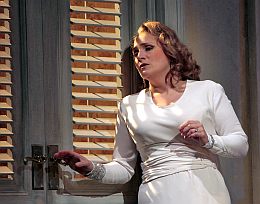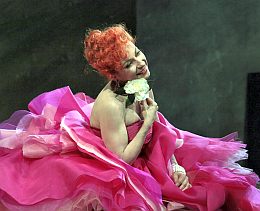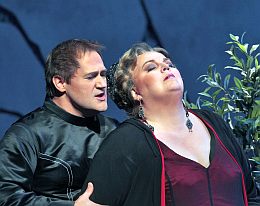This year, the principal draw was The Letter, a new “noir” opera by composer Paul Moravec and librettist Terry Teachout. Commissioned by Santa Fe Opera and based on a story by Somerset Maugham, the opera made its world premiere July 25. The season also included two significant role debuts: Natalie Dessay, singing her first Violetta in Verdi’s La traviata, and Christine Brewer, in the title role of Gluck’s Alceste. Two additional productions, Mozart’s Don Giovanni and Donizetti’s Elixir of Love, complete the lineup, continuing in rotating repertory through Aug. 29.
As always, there were Bay Area links. Dessay and Brewer have made acclaimed San Francisco Opera appearances in recent years; conductor Patrick Summers, a former Adler Fellow who returns as San Francisco’s principal guest conductor this fall, was in Santa Fe to conduct The Letter. A pair of recent San Francisco Opera Adler Fellow alums were featured in the Don Giovanni cast: Lucas Meachem in the title role, and Elza van den Heever as Donna Anna.
Still, The Letter was the main attraction. Santa Fe Opera has a long tradition of presenting new works, including the world premieres of Tobias Picker’s Emmeline (1996) and Bright Sheng’s Madame Mao (2003), as well as the American premieres of Thomas Ades’ Tempest (2006) and Kaija Saariaho’s operas L’Amour de loin (2002) and Adriana Mater (2008).
Lackluster Letter

At first glance, Maugham’s 1924 tale of lust and murder in colonial Malaya seemed a natural for operatic treatment. It has a proven track record: Maugham reworked it as a 1927 stage play, which was adapted twice for film, including the 1940 William Wyler version starring Bette Davis. Based on a historic incident, the story has all the elements of classic melodrama. In their notes, the opera’s creators said their aim was to create a new kind of American hybrid, blending the atmospherics of film noir with the visceral impact of Tosca.
It’s a pity, then, that the 95-minute opera isn’t particularly compelling. Of the three productions I attended, The Letter (seen Aug. 3), despite Jonathan Kent’s handsome staging, Summers’ emphatic musical direction, and an assured performance by soprano Patricia Racette, registered as an earnest effort, though a largely forgettable one.
The story is certainly potent. Leslie Crosbie, the lonely wife of a British rubber plantation manager, shoots her faithless lover and, claiming self-defense, is acquitted at trial, despite implicating evidence in the form of the title missive. Moravec, a Pulitzer Prize winner, and Teachout, the drama critic for The Wall Street Journal, gave their adaptation, structured in eight scenes, some nice touches, including intermittent appearances by the murdered man’s ghost and a beguiling scene with a Chinese woman who brings the letter to light. The ending, which departs from Maugham’s original, adds verismo appeal.
Moravec and Teachout prove less adept at building dramatic tension, or characterizing through music. This is the first opera for Moravec, and the score suggests influences ranging from Debussy to Wagner. The music chugs and churns and occasionally generates heat, particularly in the orchestral interludes, but sags in the vocal writing. The characters sing one cliche after another (“Far from home, trapped in a jungle, mad with rage, what have I done?”) and the arias, which tend to recap information already stated, scarcely skim the emotional surface.
Kent’s production was aptly cinematic. Hildegard Bechtler’s sets, lit by Duane Schuler, evoked noir style, while the costumes, by couture designer Tom Ford, favored white linen for the men, and tailored suits and filmy peignoirs for Leslie. Summers conducted with vigor, and the cast performed admirably. Racette poured her considerable all into the Leslie role; the soprano’s secure, gleaming vocalism made the most of the music, and she gave the character a flinty edge. Anthony Michaels-Moore was a sympathetic Robert Crosbie. Baritone James Maddalena lent eloquent voice to the conflicted feelings of the lawyer, Howard Joyce. Roger Honeywell brought lithe tone to the part of the lover, Geoff, while Mika Shigematsu made the most of her scene as the Chinese Woman. Keith Jameson, Rodell Rosel, and Sung Eun Lee made essential contributions in supporting roles. Susanne Sheston’s chorus sang with clarity.
Sounding Violetta’s Depths

At the next night’s La traviata — as on many nights at Santa Fe — the performance had hardly begun when flashes of lightning could be seen over the mountains to the west. This time, though, the natural light was eclipsed by the sheer luminosity of Natalie Dessay. Singing the first Violetta of her career, the French soprano gave a radiant, vocally resplendent performance as Verdi’s consumptive courtesan.
Dessay is a vivacious singing actress, and director Laurent Pelly, who also designed the costumes, introduced her in party-hearty mode. Making her first entrance with a whoop, in a shocking pink gown and boots, her hair cropped and colored a vivid red, she was instantly magnetic and astonishingly agile. Lifted onto the stage by three choristers, she threw herself into the first scene, leaping across Chantal Thomas’ blocky set pieces, walking across the upraised hands of the crowd, and singing brightly in the “Brindisi” toast.
It was a performance that gained in feeling and nuance as the night progressed. Dessay deploys her smallish instrument with exquisite focus and refinement, and she captured the inner life of this “flower that blooms and fades” with keen musical intelligence. In Act 2, set in a verdant yard, she projected gamine charm; later, at Flora’s party — which Pelly made decidedly decadent — she absorbed Alfredo’s shaming as a body blow. There was a splendid isolation in her portrayal, from a ravishing “Ah, fors’è lui?” in Act 1 to an otherworldly “Addio, del passato” in Act 3, after which Alfredo and his father backed out of the room, leaving her to die alone.
Dessay was dazzling, and she was matched with an excellent cast. Saimir Pirgu sang with fine, Italianate feeling as Alfredo, while Laurent Nouri (Dessay’s real-life husband) conferred dignity and elegant musical line on the role of Germont. Frederic Chaslin conducted an expansive performance, and the chorus sounded magnificent.
Uncommon Majesty
Alceste (seen Aug. 5) was also splendid. Gluck’s opera has always divided audiences into two distinct camps — those who cherish the score’s gloriously uninterrupted flow, and those who see it as an action-free slog. Santa Fe’s inaugural production may win new converts with a strong cast headed by Christine Brewer, a beguiling orchestral performance led by Kenneth Montgomery, and staging that met the opera’s challenges with a wealth of visual interest.

Based on Euripides’ tragedy Alcestis, the opera begins with King Admete of Thessaly on his deathbed. When Queen Alceste learns that the gods will allow a substitute, she volunteers to die in his place. Admete learns of the bargain and is horrified, and much of the remainder of the opera is taken up with the couple’s negotiations over who will make the ultimate sacrifice. Eventually, Hercules intervenes, and the story ends in rejoicing.
Director Francisco Negrin dispensed with traditional trappings. The sets by Louis Desire, who also designed the costumes, featured a massive stone wall and a marble sphere that cracked open to reveal a red-hot glimpse of Hades. Schuler’s lighting was dominated by neon reds and blues. The mortals wore black shifts and robes, but the gods’ glitzy outfits suggested Cirque du Soleil; the effect was both ancient and futuristic. Choreographer Ana Yepes’ ritualized movement vocabulary — upraised arms, supplicating hands, angular turns — supplied a unity missing elsewhere.
Brewer was regal in the title role. If the soprano, still apparently recovering from a knee injury, is limited in physical movement, her large, lustrous vocalism emerged unfettered. Tenor Paul Groves brought refulgent tone, fluent phrasing, and beautifully idiomatic French to the role of Admete. Wayne Tigges was a smooth-voiced Hercules; Matthew Morris’ Apollo, Tom Corbeil’s Infernal God, Jennifer Forni’s Coryphee, and Nicholas Pallesen’s Herald rounded out the cast. Montgomery coaxed warm, luxurious sound from the orchestra, and the chorus performed mightily.
